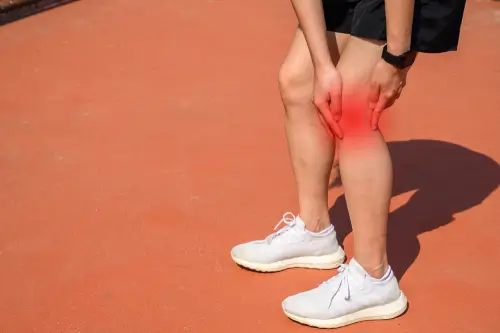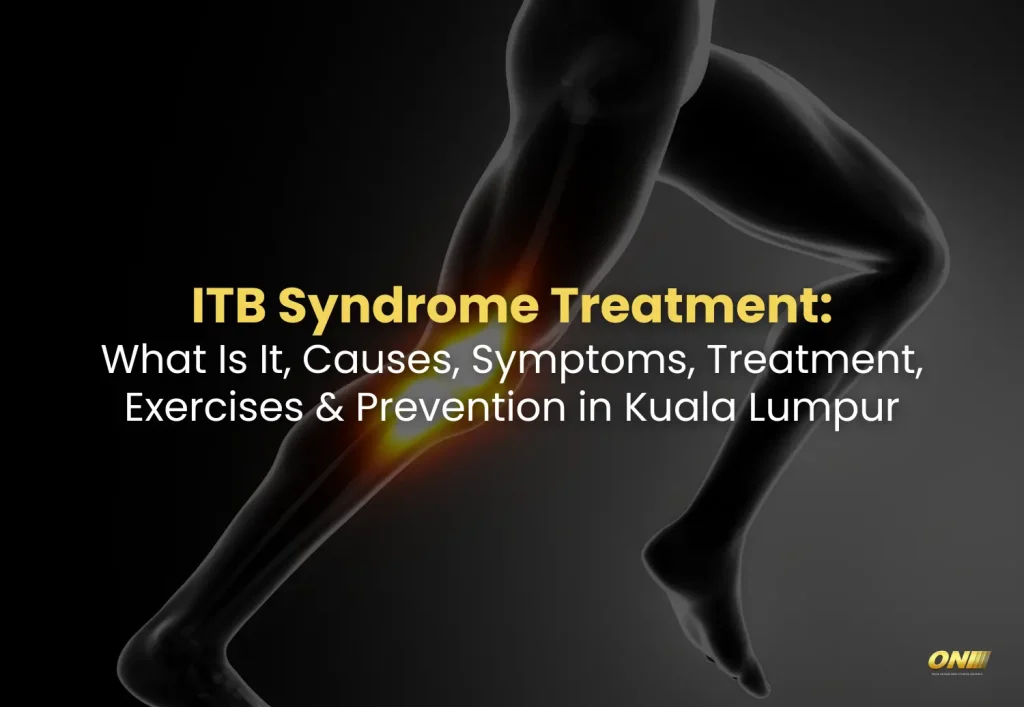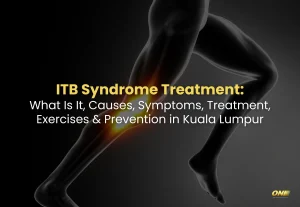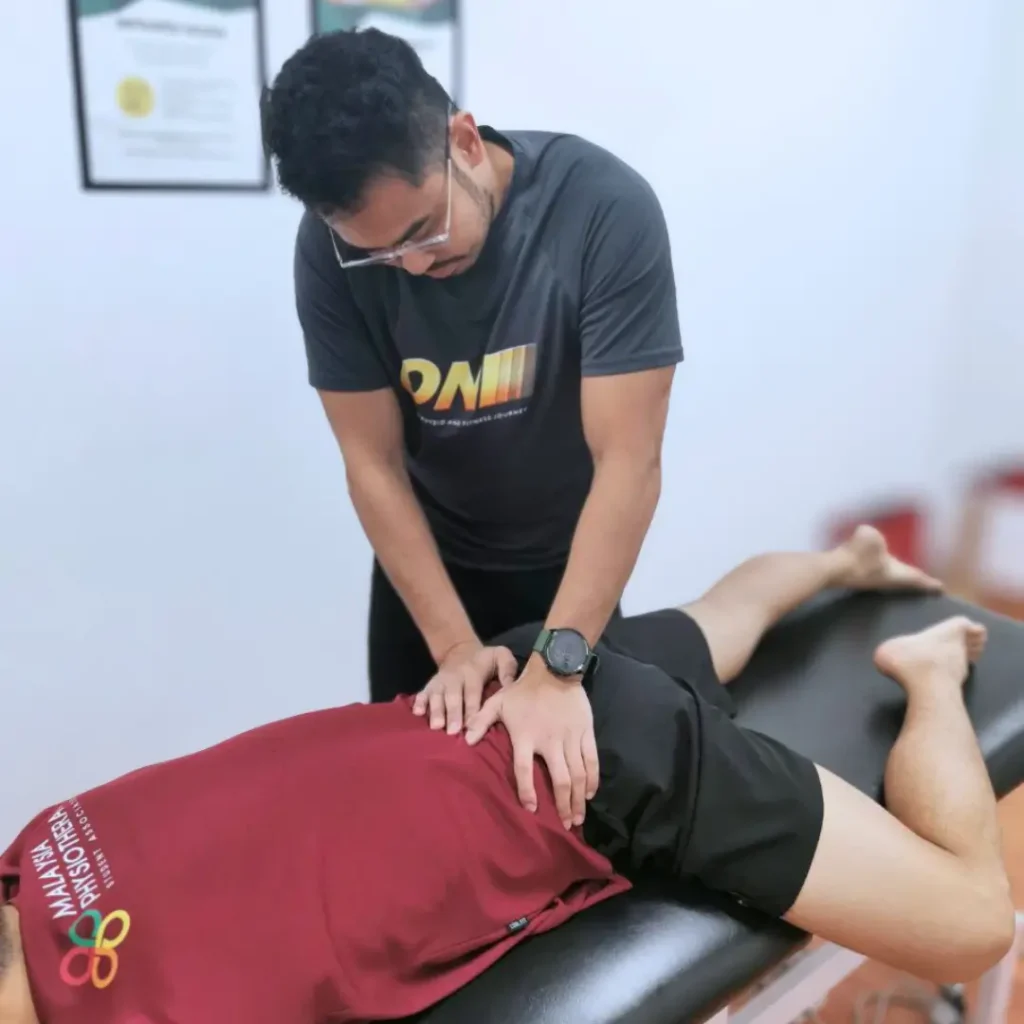Introduction
Iliotibial Band (ITB) Syndrome, is a common overuse injury that affects athletes and active individuals. The pain and discomfort associated with ITB Syndrome can make simple activities like walking or climbing stairs a challenge, let alone running or cycling.
If you’re dealing with ITB Syndrome, ONI Physio Fitness in Kuala Lumpur is here to help. This comprehensive guide will explain everything you need to know about ITB Syndrome — from its causes and symptoms to effective treatment and prevention strategies.
What Is ITB Syndrome?

The iliotibial band is a thick band of connective tissue running along the outside of the thigh, from the hip to the knee. Its primary function is to stabilize the knee joint during movement.
ITB Syndrome occurs when this band becomes tight or inflamed, causing friction against the outer knee or hip, leading to pain and discomfort. It’s most commonly seen in runners, cyclists, and other athletes involved in repetitive leg movements.
What Causes ITB Syndrome?
Several factors can contribute to the development of ITB Syndrome, including:
- Overuse: Repetitive bending and straightening of the knee can irritate the ITB.
- Muscle Imbalances: Weak glutes or hip muscles can cause uneven stress on the ITB.
- Improper Footwear: Shoes that lack proper support can lead to poor alignment, increasing strain on the ITB.
- Training Errors: Rapidly increasing training intensity, mileage, or frequency without proper recovery can overload the ITB.
- Anatomical Factors: Leg length discrepancies, flat feet, or tight hip flexors can also contribute to ITB issues.
Symptoms of ITB Syndrome
The most common symptoms of ITB Syndrome include:
- Pain on the Outer Knee: Typically felt during activities like running or walking downhill.
- Tenderness: Sensitivity or soreness along the outside of the thigh.
- Swelling: Mild swelling or warmth around the affected area.
- Clicking Sensation: Some individuals may feel a snapping or clicking sensation at the knee.
If left untreated, ITB Syndrome can worsen, limiting your ability to stay active.
ITB Syndrome Treatment in Kuala Lumpur
Recovering from ITB Syndrome requires a comprehensive and tailored approach to address both the symptoms and underlying causes. Among the most effective treatments available, physiotherapy stands out as a primary option for long-term relief and recovery.
Physiotherapy: A Holistic Solution for ITB Syndrome
Physiotherapy plays a critical role in treating ITB Syndrome by addressing the pain and dysfunction caused by tightness and inflammation of the iliotibial band. At ONI Physio Fitness, our physiotherapists begin with a thorough assessment to understand the root causes of your condition, whether it stems from muscle imbalances, poor movement patterns, or overuse.
Here’s how physiotherapy can help with ITB Syndrome:
- Pain Relief and Inflammation Management
Physiotherapists use hands-on techniques, such as myofascial release, to reduce tension in the ITB and alleviate the friction causing pain. Complementary modalities like dry needling, shockwave therapy, or cupping may also be incorporated to target inflammation and promote healing. - Improving Flexibility and Mobility
Tight tissues around the hip, thigh, and knee can limit mobility and exacerbate ITB friction. A physiotherapy program focuses on stretching and loosening these tight areas to restore normal movement patterns and reduce strain on the ITB. - Addressing Muscle Imbalances
ITB Syndrome often arises due to weaknesses in the glutes, hips, or core muscles. Physiotherapy targets these imbalances with strengthening exercises that improve stability and alignment. This not only supports recovery but also prevents the recurrence of ITB Syndrome by addressing its root cause. - Personalized Exercise Programs
Recovery from ITB Syndrome isn’t a one-size-fits-all process. A physiotherapist will design a customized exercise plan tailored to your specific needs and fitness level. This plan often includes strengthening, stretching, and functional exercises to help you return to your activities safely and effectively. - Preventing Future Injuries
Beyond treating the immediate issue, physiotherapy emphasizes educating patients on proper movement mechanics, footwear selection, and training techniques. This ensures you’re equipped with the tools and knowledge needed to prevent ITB Syndrome from recurring.
Other Treatments and Their Role
While physiotherapy forms the cornerstone of ITB Syndrome treatment, additional treatments like medications for pain management or, in rare cases, surgical interventions may be necessary for severe cases. However, these options are typically reserved for individuals who do not respond to conservative care.
At ONI Physio Fitness, we specialize in providing personalized physiotherapy programs that combine manual therapy, advanced modalities, and targeted exercises. Our goal is not only to relieve your current pain but also to equip you with the tools to stay injury-free in the long term.
Exercises for ITB Syndrome
Incorporating targeted exercises is essential for managing ITB Syndrome. Here are three recommended exercises:
1. Hip Bridge
- Lie on your back with knees bent and feet flat on the ground.
- Engage your glutes and lift your hips towards the ceiling.
- Hold for 5 seconds, then lower slowly.
- Repeat 10–15 times.
2. Side-Lying Leg Lifts
- Lie on your side with legs stacked.
- Lift the top leg to hip height, keeping it straight.
- Lower slowly without letting it touch the bottom leg.
- Repeat 10–15 times per side.
3. ITB Stretch
- Stand and cross your affected leg behind the other.
- Lean towards the unaffected side until you feel a stretch along the ITB.
- Hold for 20–30 seconds.
- Repeat 2–3 times.
How to Prevent ITB Syndrome
Prevention is always better than cure. Follow these tips to avoid developing ITB Syndrome:
- Warm-Up Properly: Start each workout with dynamic stretches to prepare your muscles.
- Strength Training: Incorporate exercises to strengthen your glutes, hips, and core.
- Gradual Progression: Avoid sudden increases in training intensity or volume.
- Check Your Footwear: Use supportive shoes designed for your activity.
- Listen to Your Body: Rest if you experience pain or discomfort during activity.
Why Choose ONI Physio Fitness for ITB Syndrome Treatment in Kuala Lumpur?
At ONI Physio Fitness, our experienced physiotherapists provide comprehensive assessments to identify the root cause of your pain. We combine manual therapies, advanced modalities, and tailored exercise programs to ensure effective and long-lasting results.
We serve clients in Mont Kiara, Kuala Lumpur, Petaling Jaya, and Sri Hartamas, offering convenient and accessible care to help you get back to doing what you love.
Conclusion
ITB Syndrome can be frustrating and painful, but with the right treatment, you can recover fully and prevent it from coming back. At ONI Physio Fitness, we specialize in treating ITB Syndrome using techniques like myofascial release, dry needling, and personalized exercise plans to address the root cause of your condition.
Don’t let ITB Syndrome hold you back. Book an appointment with ONI Physio Fitness today and take the first step towards pain-free movement and improved performance.
















